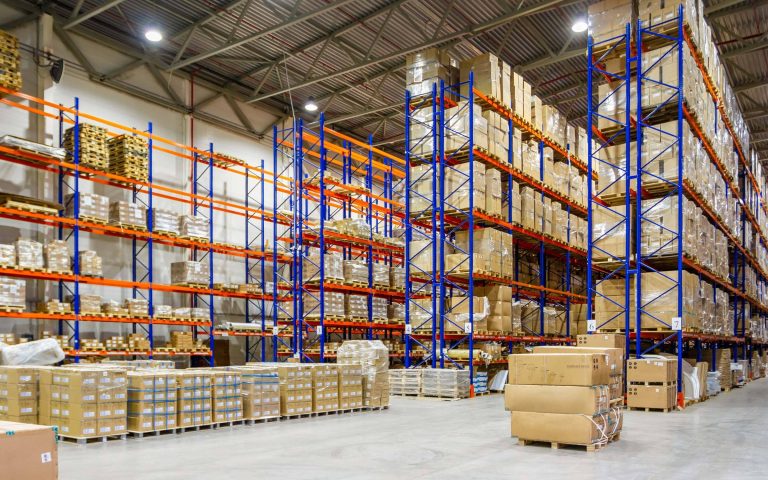In a warehouse, every inch of space counts. Misusing or underutilizing that space costs way more than just square footage. When you’re tasked with storing long, bulky, or irregularly shaped materials, the challenge becomes even greater. Fortunately, used cantilever racks offer a cost-effective and flexible solution, especially when you’re trying to stretch your budget without compromising performance or safety.
What Are Cantilever Racks?
Cantilever racks are warehouse storage systems designed to hold long or awkwardly shaped items that don’t fit neatly on traditional pallet racks. From lumber to steel pipes to furniture and drywall, used cantilever racking systems help store large materials efficiently.
Unlike standard shelving systems that rely on vertical posts and horizontal beams, cantilever racking uses upright columns and horizontal arms that extend outward (kind of like tree branches) to support loads without any obstructions.
The basic components of a cantilever rack include:
- Uprights: The vertical columns anchored to the floor.
- Bases: These provide stability and serve as additional storage support.
- Arms: Extend from the uprights to hold materials and can be straight or inclined depending on the load.
- Bracing: Connects the uprights to maintain structural rigidity.
Cantilever racks come in single-sided or double-sided configurations. Single-sided systems are designed to sit flush against a wall while double-sided systems offer access from both sides and are ideal for central aisles.
Their open-front design makes loading and unloading easier, especially with forklifts or side loaders.
Why Choose Used Cantilever Racks?
Investing in warehouse infrastructure can be expensive. Used cantilever racking offers an affordable solution.
1. Cost Savings
Used cantilever racks can often be sourced at 30–50% less than new systems. For facilities with large or multi-bay requirements, that discount can translate into tens of thousands of dollars in savings.
2. Immediate Availability
New racking systems often come with lead times, especially if custom sizes or configurations are required. Used racking, on the other hand, is often available immediately.
3. Environmental Sustainability
Reusing equipment supports sustainability goals by reducing industrial waste and extending the life cycle of heavy-duty steel materials. For warehouses working toward environmental certifications or internal green initiatives, using reclaimed racking helps.
4. Industrial Durability
Most cantilever racks are made from heavy-duty steel and designed to withstand decades of wear. When properly inspected and maintained, used cantilever racking can deliver performance comparable to brand-new systems. In fact, many systems on the secondary market have only seen light use or were decommissioned due to warehouse relocations and still have a long usable life ahead.
Key Considerations When Buying Used Cantilever Racking
While used cantilever racks can offer incredible value, not all equipment on the secondary market is top quality, and you can’t afford to equip your warehouse with sub-standard racks. To ensure you’re getting a safe and long-lasting system, here are several factors to consider before making a purchase.
1. Inspect the Condition
Always inspect for:
- Visible rust or corrosion (especially on arms and base plates)
- Dents, bends, or deformation in uprights or arms
- Missing or mismatched hardware
- Weld integrity (no signs of cracking or fatigue)
Even high-quality steel racks can degrade over time if improperly stored or used beyond their rated capacity.
2. Know Your Load Requirements
Make sure the racking system can handle the type and weight of material you plan to store. Manufacturer specifications should list:
- Arm capacity (per level)
- Column capacity (total per bay)
- Maximum arm length and spacing
3. Ensure Space Compatibility
You need the right equipment in the right space for optimal throughput. Examine:
- Floor layout and anchoring zones
- Aisle widths for forklift clearance
- Overhead clearance for top-level arms
- Ability to expand or reconfigure in the future
Cantilever racks offer modularity, but it’s important to match your space with the right configuration.
4. Verify Expandability
If your inventory or volume may increase over time, it’s smart to buy a system that allows for arm adjustments or the addition of extra bays. Some used systems may come with unique arm locking mechanisms or proprietary hardware, so be sure you’ll be able to expand as needed.
5. Choose a Reputable Source
Buy from warehouse equipment specialists who thoroughly inspect, refurbish, and guarantee their used inventory. Working with professionals ensures you get equipment that’s safe, reliable, and correctly matched to your needs rather than settle for whatever happens to be sitting in a salvage yard.
Safety and Compliance
Warehouses can be dangerous places. OSHA reports that the warehouse and storage industry has an injury rate that’s nearly double that of the national average of other occupations. Cantilever racks may look simple, but they are still subject to the same safety protocols as any industrial storage system.
Whether new or used, racks must be installed and maintained according to code. This includes:
- Always anchoring uprights securely to a concrete floor using manufacturer-recommended hardware.
- Making sure the base plates are level and flush with the ground.
- Bracing between uprights to prevent tipping and sway.
You’ll also want to make sure your racks meet OSHA guidelines and Rack Manufacturers Institute (RMI) standards, especially for storing heavy or hazardous materials.
Buy Used Cantilever Racking
For warehouses that need to store long, bulky, or irregular materials, used cantilever racks offer a flexible and cost-effective storage solution.
Choosing the right used cantilever racking system depends on your specific materials, space, and load requirements. If you’d like guidance on what to look for, we’re here to help.



